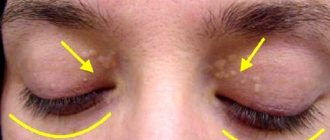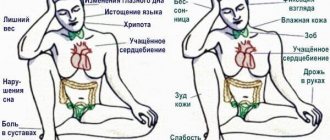- Diet
Impaired glucose tolerance (IGT) is a form of latent diabetes, characterized by the absence of clinical signs of diabetes with an inadequate increase in blood sugar levels and a slow decrease under the influence of various reasons (usually after eating). This is a high-risk condition for developing clinically significant diabetes mellitus in the future. In addition, people with impaired glucose tolerance usually have more severe comorbidities.
Timely detection of such a disorder of carbohydrate metabolism allows one to take measures to avoid the development of diabetes mellitus, or at least significantly delay its occurrence. Diagnosis is simple; all you need to do is perform an oral glucose tolerance test.
Synonyms: prediabetes, asymptomatic diabetes, subclinical diabetes, hidden diabetes, latent diabetes.
In the International Classification of Diseases, 10th edition (ICD-10), the disease is coded R73.0.
Causes and risk factors
The origin of carbohydrate metabolism disorders is reflected in the classification of diabetes mellitus published by the World Health Organization in 1999. Glucose tolerance may decrease for the following reasons:
| Etiological factor | Decoding |
| Genetic disorders | · Impaired function of β-cells (insulin-producing cells of the pancreas); Impaired absorption of insulin; · genetically determined destruction of β-cells; Genetically determined insulin resistance. |
| Endocrinopathies | Itsenko-Cushing syndrome, thyrotoxicosis, pheochromocytoma, acromegaly, etc. |
| Obesity | BMI (body mass index) ≥ 25 kg/m2 |
| Viral infections | · Epstein–Barr virus; · cytomegalovirus; · mumps virus. |
| Diabetogenic drugs and other chemicals | Glucocorticoids, α-adrenergic receptor agonists, thiazides, α-interferon, pentamidine, etc. |
| Genetic and chromosomal syndromes accompanied by impaired glucose tolerance | Down syndrome, Shereshevsky-Turner, Lawrence-Moon, Wolfram, Huntington's chorea, etc. |
| Diseases of the exocrine pancreas | Pancreatitis, cystic fibrosis, some neoplasias. |
Factors that contribute to the development of prediabetes are many and varied. These include:
- excess body weight;
- family history of diabetes mellitus;
- sedentary lifestyle;
- age over 45 years;
- arterial hypertension;
- deviations from the norm in the content of HDL cholesterol in the blood;
- increased levels of triglycerides in the blood;
- some metabolic disorders (gout, hyperuricemia, atherosclerosis, metabolic syndrome);
- chronic diseases of the liver, kidneys, cardiovascular system;
- furunculosis;
- periodontal disease;
- history of gestational diabetes;
- miscarriage, pregnancy resulting in stillbirth, premature birth, history of an excessively large fetus;
- severe stress, major surgery, history of serious illness.
All people with these conditions should have a glucose tolerance test regularly.
Causes of the disease
IGT (impaired glucose tolerance) has its own ICD 10 code - R 73.0, but is not an independent disease. This pathology is a frequent companion to obesity and one of the symptoms of metabolic syndrome. The disorder is characterized by a change in the amount of sugar in the blood plasma, which exceeds the permissible levels, but does not yet reach hyperglycemia.
This happens due to a failure in the absorption of glucose into organ cells due to insufficient sensitivity of cellular receptors to insulin.
This condition is also called prediabetes and, if left untreated, a person with IGT will sooner or later face a diagnosis of “type 2 diabetes mellitus.”
The disorder is detected at any age, even in children and in most patients, varying degrees of obesity are recorded. Excess weight is often accompanied by a decrease in the sensitivity of cell receptors to insulin.
In addition, NTG can be triggered by the following factors:
- Low physical activity . A passive lifestyle combined with excess weight leads to poor circulation, which in turn causes problems with the heart and vascular system, and affects carbohydrate metabolism.
- Treatment with hormonal drugs . Such drugs lead to a decrease in the cellular response to insulin.
- Genetic predisposition . The mutated gene affects the sensitivity of the receptors or the functionality of the hormone. This gene is inherited, which explains the discovery of impaired tolerance in childhood. Thus, if parents have problems with carbohydrate metabolism, then the child also has a high risk of developing IGT.
It is necessary to undergo a blood test for tolerance in the following cases:
- pregnancy with a large fetus;
- the birth of a large or stillborn child in previous pregnancies;
- hypertension;
- taking diuretics;
- pathology of the pancreas;
- low levels of lipoproteins in the blood plasma;
- presence of Cushing's syndrome;
- people after 45-50 years old;
- high triglyceride levels;
- attacks of hypoglycemia.
Symptoms
There are no clinical manifestations of impaired glucose tolerance - this is why it is called asymptomatic or subclinical diabetes. The condition can only be detected when a glucose tolerance test is performed as part of a preventive examination or diagnostic examination for another reason.
However, experts tend to consider certain signs as potentially indicating a possible violation of glucose tolerance, in particular:
- susceptibility to skin diseases (furunculosis, fungal infection, pyoderma, itchy skin), alopecia:
- bleeding gums, periodontal disease;
- intestinal dysbiosis, irritable bowel syndrome, pancreatic dysfunction;
- menstrual cycle disorders in women, sexual dysfunction in men, candidiasis of the genitourinary system;
- angioneuropathy, retinopathy, obliterating endarteritis.
Features of impaired glucose tolerance in children
Despite the fact that in children and adolescents, impaired glucose tolerance usually develops under the influence of a stress factor and is transient in nature, when confirmed in order to avoid a false positive result, it indicates the presence of type 1 diabetes mellitus (juvenile, insulin-dependent diabetes). In this case, impaired glucose tolerance is considered not as prediabetes, but as a stage in the development of type 1 diabetes mellitus, preceding its manifestation. Unlike latent diabetes in adults, prediabetes in children is irreversible and requires constant monitoring of blood glucose levels in order to begin insulin therapy in a timely manner.
Diagnostics
The method for diagnosing impaired glucose tolerance is a special glucose tolerance test, since a regular test that determines blood glucose levels at the stage of prediabetes will not have deviations from the norm. The glucose tolerance test is a safe, inexpensive and at the same time very informative method.
The test determines the adequacy of endogenous insulin secretion, which is manifested in the body’s ability to maintain normal blood glucose levels under conditions of stress loading with drinking glucose.
Contraindications to the glucose tolerance test
- blood glucose level is above the diagnostic threshold for diabetes mellitus (7 mmol/l);
- the glucose level at any time of the day, regardless of food intake, corresponds to 11.1 mmol/l and above;
- recent surgery, myocardial infarction;
- postpartum period.
Preparing for the test
For three days before the study, the patient must adhere to his usual physical activity and diet, including at least 150 g of carbohydrates per day. The last meal should occur no later than 12 hours before the test. 15 minutes before the start of the test and throughout its entire duration, the patient must remain in a state of physical rest. This should not be preceded by stress, physical overload or illness.
Carrying out the test
During the test, the patient must be calm and sit or lie comfortably.
The test is performed in the morning on an empty stomach.
Blood is drawn from a finger (capillary blood). Immediately after this, the patient is given a glucose solution to drink (75 g of dry glucose in 250 ml of water), to which a few drops of lemon juice or citric acid solution are sometimes added in order to avoid nausea and other unpleasant sensations. The exact amount of glucose is calculated based on 50 g/m2 of body surface, but not more than 75 g for adults, for obesity - at the rate of 1 g/kg body weight, but not more than 100 g. The amount of glucose for children and adolescents is 1.75 g /kg body weight, but not more than 75 g.
After consuming glucose on an empty stomach, capillary blood is collected after 30, 60, 90, 120 minutes. During a preventive examination, the test can be carried out using a simplified method, when the first blood sample is taken, as in the classic version, before the glucose load, and the second and last - after 120 minutes.
Interpretation of sample results
Normally, blood glucose levels increase immediately after a glucose load and then quickly decrease. The initial glucose level should be less than 5.5 mmol/L, after 30, 60 and 90 minutes should not exceed 11.1 mmol/L, and after 120 minutes should be below 7.8 mmol/L.
If fasting blood glucose exceeds 5.5 mmol/L, but below 6.1 mmol/L, and after 120 minutes is in the range of 7.8–11.1 mmol/L, impaired glucose tolerance is diagnosed.
If the fasting blood glucose level exceeds 6.1 mmol/l, and 120 minutes after the glucose load is ≥ 11.1 mmol/l, diabetes mellitus is diagnosed.
If the fasting blood glucose level is in the range of 5.6–6.0 mmol/l, they speak of impaired fasting glycemia, this condition indicates an existing risk of developing diabetes mellitus.
In people over 60 years of age, 0.1 mmol/l is added to the obtained blood glucose levels every 10 years.
Quote: Studies by foreign endocrinologists show that 10% of people aged 60 years and older exhibit impaired glucose tolerance.
Additional diagnostics
An auxiliary diagnostic criterion to confirm the diagnosis of impaired glucose tolerance or diabetes mellitus is the determination of the level of glucose in urine collected after a glucose load.
Another supportive method is to measure glycated hemoglobin (HbA1c), an indirect measure of the average blood glucose concentration over a long period. Normal HbA1c is 4-6%. At the same time, detection of elevated HbA1c in people without clinical manifestations of diabetes requires a blood glucose test and a glucose tolerance test.
The glucose tolerance test consists of determining the level of plasma glucose and insulin on an empty stomach and 2 hours after a carbohydrate load in order to diagnose various disorders of carbohydrate metabolism (insulin resistance, impaired glucose tolerance, diabetes mellitus, glycemia).
Synonyms Russian
GTT.
English synonyms
Glucose tolerance test, GTT, Oral glucose tolerance test.
Research method
Electrochemiluminescent immunoassay - insulin; enzymatic UV (hexokinase) - glucose.
Units
Mmol/l (millimoles per liter) - glucose, µU/ml (microunit per milliliter) - insulin.
What biomaterial can be used for research?
Venous blood.
How to properly prepare for research?
- Do not eat for 12 hours before the test; you can drink clean still water.
- Completely avoid (in consultation with your doctor) taking medications for 24 hours before the test.
- Do not smoke for 3 hours before the test.
General information about the study
A glucose tolerance test is a measurement of blood glucose levels on an empty stomach and 2 hours after oral administration of a glucose solution (usually 75 g of glucose). Taking a glucose solution increases the level of glucose in the blood during the first hour, then insulin is normally produced in the pancreas and during the second hour the level of glucose in the blood returns to normal.
The glucose tolerance test is used in the diagnosis of diabetes (including gestational diabetes), and is a more sensitive test than the determination of fasting glucose. In clinical practice, the glucose tolerance test is used to detect prediabetes and diabetes in individuals with borderline fasting blood glucose levels. In addition, this test is recommended for early detection of diabetes in persons at increased risk (overweight, with diabetes in relatives, with previously identified cases of hyperglycemia, with metabolic diseases, etc.). The glucose tolerance test is contraindicated in case of high fasting glucose levels (more than 11.1 mmol/l), as well as in acute diseases, children under 14 years of age, in the last trimester of pregnancy, and when taking certain groups of drugs (for example, steroid hormones).
To increase clinical relevance, blood insulin levels are used in conjunction with the measurement of glucose levels in the glucose tolerance test. Insulin is a hormone produced by the beta cells of the pancreas. Its main function is to reduce the concentration of glucose in the blood. Knowing the insulin levels before and after taking a glucose solution, the glucose tolerance test can assess the severity of the pancreas response. By identifying deviations in results from the normal ratio of glucose and insulin levels, the diagnosis of the pathological condition is greatly facilitated, which accompanies an earlier and more accurate diagnosis.
It is important to note that the prescription and interpretation of the results of a glucose tolerance test with measurement of blood insulin levels is carried out only by the attending physician.
What is the research used for?
- For the diagnosis of carbohydrate metabolism disorders.
When is the study scheduled?
- For symptoms of hypoglycemia to classify different types of diabetes;
- when determining the glucose/insulin ratio, as well as to assess insulin secretion and β-cell function;
- when identifying insulin resistance in patients with arterial hypertension, hyperuricemia, elevated levels of triglycerides in the blood, type 2 diabetes mellitus;
- if insulinoma is suspected;
- when examining patients with obesity, diabetes, metabolic syndrome, polycystic ovary syndrome, chronic hepatitis, non-alcoholic liver steatosis;
- when assessing the risk of developing diabetes and cardiovascular diseases.
What do the results mean?
Glucose
Reference values
Fasting: 4.1 - 6.1 mmol/l;
in 120 min. after exercise: 4.1 - 7.8 mmol/l.
| Diagnostic criteria for diabetes mellitus and other glycemic disorders* Diabetes | |
| On an empty stomach | ≥ 7,0 |
| 2 hours after exercise | ≥ 11,1 |
| Impaired glucose tolerance | |
| On an empty stomach | |
| 2 hours after exercise | ≥ 7.8 and |
| Impaired fasting glycemia | |
| On an empty stomach | ≥ 6.1 and |
| 2 hours after exercise | |
Markers of prediabetes (diabetes):
- fasting glucose level is higher than normal and/or after exercise is higher than normal; Insulin levels may be low.
Possible causes of elevated plasma glucose levels:
- various disorders of carbohydrate metabolism (impaired glucose tolerance, fasting glycemia);
- false positive result – recent or ongoing acute illness, surgery, stress.
Possible causes of low plasma glucose levels:
- taking medications that lower glucose levels (insulin, sugar-lowering drugs);
- insulinoma;
- starvation;
- intense physical activity on the eve of the test.
Insulin
Reference values: 2.6 - 24.9 µU/ml.
Reference values for insulin 2 hours after exercise are not given; interpretation of the results is carried out by the attending physician.
A marker of insulin resistance and a precursor to the development of type 2 diabetes:
- the insulin level after exercise increased more than three times compared to the “fasting” value; The glucose level may be equal to the “fasting” value or lower.
Possible causes of elevated insulin levels:
- polycystic ovary syndrome;
- Itsenko-Cushing syndrome;
- fructose or glucose-galactose intolerance;
- insulinoma;
- obesity;
- Insulin resistance, as in chronic pancreatitis (including cystic fibrosis) and pancreatic cancer.
Possible causes of low insulin concentration:
- β-cell destruction (DM, type I);
- decreased insulin activity,
- decreased synthesis of insulin by the pancreas (DM, type II);
- circulation of antibodies to insulin;
- delayed release of insulin;
- absence (or insufficient number) of insulin receptors.
Treatment of impaired glucose tolerance
At the stage of prediabetes, to normalize impaired carbohydrate metabolism, lifestyle correction is sufficient, which, however, should not be temporary, but lifelong.
At the stage of prediabetes, it is still possible to avoid the development of a clinically significant disease
Diet
The main treatment for impaired glucose tolerance is diet. Its main principles:
- Reducing the fat content in the diet to 40-50 g per day.
- Reduce salt intake to 6 g per day maximum.
- Reducing the consumption of simple carbohydrates (products made from white flour and pastry, confectionery, sugar, honey).
- Daily consumption of a small amount of complex carbohydrates (whole grain flour products, potatoes, cereals with the exception of semolina), evenly distributed over several meals.
- Preference for a dairy-vegetable diet (fresh and cooked vegetables, fruits and berries, dairy and fermented milk products should be included in the daily diet). Fermented milk products, in addition to their nutritional value, help prevent intestinal dysbiosis, which often accompanies carbohydrate metabolism disorders.
- Refusal of alcoholic beverages.
- Fractional diet: 5-6 meals a day in small portions, maintaining equal time intervals between meals.
- In case of obesity, the daily calorie content (determined individually taking into account gender, age, type of activity) of food should be reduced by 200-300 kcal until normal body weight is achieved.
Other recommendations
- Quitting smoking and other bad habits.
- Avoid physical inactivity, increase physical activity. Daily physical activity without overwork is necessary.
- Regular monitoring of blood sugar levels.
- Normalization of work and rest schedules, a good night's sleep.
- Refusal of heavy physical labor and night shifts.
- Observation by an endocrinologist with an annual examination, which includes a glucose tolerance test and determination of HbA1c.
Treatment of IGT
What to do if NTG is confirmed?
Typically clinical recommendations are as follows:
- regularly monitor blood sugar levels;
- monitor blood pressure readings;
- increase physical activity;
- follow a diet to achieve weight loss.
Additionally, medications may be prescribed to help reduce appetite and accelerate the breakdown of fat cells.
The importance of proper nutrition
Adhering to the principles of proper nutrition is useful even for a completely healthy person, but in a patient with a disorder of carbohydrate metabolism, changing the diet is the main point of the treatment process and following a diet should become a way of life.
The dietary rules are as follows:
- Fractional meals. You need to eat more often, at least 5 times a day and in small portions. The last snack should be a couple of hours before bedtime.
- Drink 1.5 to 2 liters of clean water daily. This helps thin the blood, reduce swelling and speed up metabolism.
- Bread products made from wheat flour, as well as desserts with cream, sweets and candies are excluded from consumption.
- Limit consumption of starchy vegetables and alcoholic beverages to a minimum.
- Increase the amount of fiber-rich vegetables. Legumes, greens and unsweetened fruits are also allowed.
- Reduce the consumption of salt and spices in your diet.
- Replace sugar with natural sweeteners; honey is allowed in limited quantities.
- Avoid dishes and foods with a high percentage of fat in the menu.
- Low-fat dairy and fermented milk products, fish and lean meat are allowed.
- Bread products must be made from whole grain or rye flour, or with the addition of bran.
- For cereals, give preference to pearl barley, buckwheat, and brown rice.
- Significantly reduce high-carbohydrate pasta, semolina, oatmeal, and refined rice.
Avoid fasting, overeating, and low-calorie diets. The daily calorie intake should be in the range of 1600-2000 kcal, where complex carbohydrates account for 50%, fats approximately 30% and protein foods 20%. If you have kidney disease, the amount of protein decreases.
Physical exercise
Another important point of therapy is physical activity. To lose weight, you need to provoke intense energy expenditure, in addition, this will help reduce sugar levels.
Regular physical exercise accelerates metabolic processes, improves blood circulation, strengthens vascular walls and heart muscle. This prevents the development of atherosclerosis and heart disease.
Aerobic exercise should be the main focus of physical activity. They lead to an increase in heart rate, which accelerates the breakdown of fat cells.
For people suffering from hypertension and pathologies of the cardiovascular system, low-intensity exercises are more suitable. Slow walks, swimming, simple exercises, that is, anything that does not lead to increased blood pressure and shortness of breath or heart pain.
For healthy people, classes should be more intense. Running, jumping rope, cycling, skating or skiing, dancing, and team sports are suitable. A set of physical exercises should be designed in such a way that the majority of the workout is aerobic exercise.
It is good to alternate the intensity of the loads, starting with a slow pace, then speeding up and again reducing the pace of movements.
The main condition is regularity of classes. It is better to devote 30-60 minutes daily to sports activities than to exercise for two to three hours once a week.
It is important to monitor your well-being. The appearance of dizziness, nausea, pain, and signs of hypertension should be a signal to reduce the intensity of the exercise.
Prevention
A measure to prevent the development of a prediabetic state is, first of all, maintaining a healthy lifestyle, which involves proper nutrition, regular and sufficient physical activity, a normal work and rest schedule, and resistance to stress.
Secondary prevention includes timely detection of carbohydrate metabolism disorders (regular preventive examinations) and measures to eliminate it, including registration with an endocrinologist.










